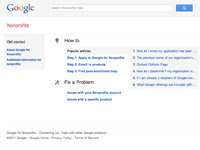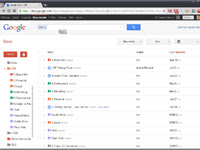Google for Nonprofits Newsletter - October 2011
41 views
Skip to first unread message
Leslie Hernandez
Oct 31, 2011, 8:35:43 PM10/31/11
to googlefor...@googlegroups.com
|
| ||||||||||
|
Google for Nonprofits Newsletter - October 2011 | ||||||||||
| Your monthly round-up of the latest news and notes from Google for Nonprofits. | ||||||||||
| October 31, 2011 | ||||||||||
| ||||||||||
| ||||||||||
| Greetings from the Google for Nonprofits team! Fall is in full swing, and we’ve got lots of great updates for you from the Google for Nonprofits team, some new ways nonprofits are using Google Docs & YouTube and a few projects we think you should know about. We hope you have a wonderful Halloween and here’s to a bountiful and productive November. | ||||||||||
| ||||||||||
| ||||||||||
| ||||||||||
| ||||||||||
| ||||||||||
| ||||||||||
Q: What is Google Crisis Response?
A: Google Crisis Response is a team of Googlers focused on improving disaster response and preparedness activities. We disseminate emergency information and create tools to help people affected by crises as well as first responders working in the field. Q: What does the Google Crisis Response team typically do during times of disaster?
A: I spent several years 24/7 on call for the UN and with search and rescue groups and find that I'm still this way at google.org. Basically when an event happens we assess the situation, and then work with government and nonprofit first response organizations to collect and communicate to the public important information about the crisis. This ranges from maps of storm paths, to new satellite imagery, to the locations of shelter and relief stations. For example in Hurricane Irene, we worked with partners to show storm paths and flood maps, and we have an agreement with the American Red Cross to show shelter locations. Our CrisisMaps and Landing pages are two ways we present this sort of information. We also launch relevant applications such as Google Person Finder to help people locate friends and loved ones in the aftermath of a disaster, like we just did in Turkey for the recent earthquake. Q: What are some of the Crisis Response tools that first responders use on the ground?
A: First responders employ many of the same tools nonprofits use on a day-to-day basis to aid in disaster management. For example, many are using Google Earth to map and plan events and responses, and tools like Fusion Tables to store and visualize crisis data, and My Maps to present and share information such as road closures and power outages. And, they use Google Docs and Spreadsheets so volunteers, staff, and partners can collaboratively track and communicate their activities. See some case studies of these tools in action on our resources page. Q: Do you have any tips for organizations to prepare for crises?
A: We encourage all organizations to try out Google's tools: we’ve created some tutorials and case studies to make this easier. Organizations that are responsible for getting information out quickly and broadly to the public in times of crisis should also prepare by ensuring they can update info dynamically through feeds (like a blog or RSS feed) rather than via static website content. And, they should publish data in open formats including KML for geographic information and CAP for other emergency information to allow others to easily view, repurpose, and communicate their information. Q: Can you give us a sneak peek of any new tools for crisis response that your team is currently working on?
A: We’re working on new ways to quickly and dynamically post emergency information from credible sources to the places where people are looking during crises: Google Search, Google Maps and mobile. We’re building relationships to get better and more reliable emergency data from government agencies and other groups so we (and others) can channel it to the public when and where it matters most. If you work for such an organization and would like provide us with your emergency data, make sure your alerts are in the Common Alerting Protocol (CAP 1.2) and sign them up on Google's alerthub. We can work with you from there. | ||||||||||
| ||||||||||
|
Share your story! Have you had a great experience with a Google product that you'd like to share? Tell us about it. |
||||||||||
| ||||||||||
| If someone sent you this email and you’d like to join our mailing list, click here. | ||||||||||
|
Reach more donors | Improve operations | Raise awareness Make a change: google.com/nonprofits | ||||||||||
| 2011 Google Inc. All Rights Reserved. Google and the Google logo are trademarks of Google Inc. www.google.com 1600 Amphitheatre Parkway, Mountain View, CA 94043 |
Reply all
Reply to author
Forward
0 new messages







